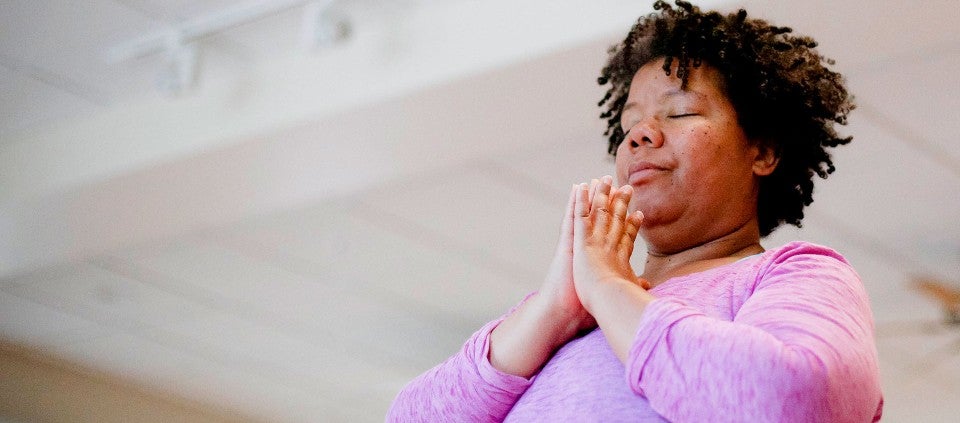The Benefits of Conscious Breathing for Body and Mind

May 29, 2020
“Feelings come and go like clouds in a windy sky. Conscious breathing is my anchor.”
―Thích Nhat Hanh
Yogic breathing is a fundamental practice in the study of yoga. As one of the limbs of Patanjali’s eight-limbed path, yogic breathing, or pranayama, is defined as the “control of life force,” and is aimed at increasing vital energy in the body and mind.
Most of us have noticed that the way we breathe can impact both our body and mind. Yoga students report feeling more calm and centered; being better able to navigate intense emotional feelings, and sleeping more soundly. For most yoga students, the practice of conscious breathing is foundational to the practice of yoga. Breath work can also help mitigate the negative impact of stress and trauma.
Breathing practices "can balance, strengthen, and increase the adaptive flexibility of stress response systems, potentially counteracting the detrimental effects of excess stress, neglect, and trauma on emotion regulation, physical health, and the ability to experience love and compassion," say Kripalu presenters Richard P. Brown and Patricia L. Gerbarg, whose Breath-Body-Mind approach has been shown to benefit healthcare practitioners, individuals with psychiatric and medical conditions, at-risk children, veterans, active duty military, and survivors of disasters—the 9/11 World Trade Center attacks, Haiti earthquake, Gulf Horizon oil spill, slavery in Sudan, genocide in Rwanda, and Rohingya refugee children in Bangladesh.
Intrigued by these reports, scientists have begun to turn an eye to this practice. Why is yogic breathing so helpful? What are the key benefits of this practice? An important research finding is that yoga can increase stress resilience. But how? The answer to this question lies in understanding one of the primary systems affected by yoga—the autonomic nervous system.
The autonomic nervous system regulates our stress response.
The autonomic nervous system (ANS) is connected to physical processes such as digestion, respiration, heart rate, immune function, and peristalsis. This system has two branches, the sympathetic system and the parasympathetic system.
The sympathetic nervous system (SNS) is our fight-or-flight response. It helps us to mobilize energy to complete a task—whether it’s a work-related task or the task of predatory survival. In small doses, the SNS is essential, but when it goes into overdrive, the body and mind suffer. The decreased blood flow to the gastrointestinal (GI) tract and prolonged high blood pressure caused by the fight-or-flight response can lead to digestive problems, cardiovascular disease, and anxiety, among other conditions.
The other branch of the system is the parasympathetic nervous system (PNS), often called the “rest and digest” or “calm and connect” system, which allows us to recoup from the stressors of life. If you find yourself breathing slowly and deeply, feeling a sense of calm and peacefulness, your PNS is activated, enhancing digestion, increasing blood flow to the GI track, lowering the heart rate, and enhancing sexual arousal. This system also activates certain parts of the brain, dampening fear-response regions and increasing the reflective, responsive regions. The result? More reflective, conscious behavior and action; an increased feeling of calm; and greater mental flexibility and creativity amid life’s challenges.
Stress resilience is a balance of these two systems. It’s not that stress-resilient people don’t have periods of SNS activity, but they can more easily bring the PNS back online and de-escalate the SNS when the task, or stressor, is over. They experience a fluid flexibility between the two systems.
Yogic breathing techniques can support the nervous system.
The respiratory system is the one system of the ANS over which we have conscious control. And because air intake is essential for life, the brain responds to the respiratory system with urgency. That’s why yogic breathing can make such an impact on overall health. It’s a place where we can begin to plug into our nervous system and support its overall function and balance.
One pranayama technique that has been shown to improve stress resilience is Coherent Breathing, which is essentially full yogic breathing with a focus on finding the number of breaths per minute (usually between 3.5 and 6) to optimize the effect on stress resilience.
In their book,The Healing Power of the Breath, Richard and Patricia write that when this “sweet spot” is found, the electrical rhythms of the heart, lungs, and brain become synchronized. They report that this breath rate can “induce up to a tenfold improvement in heart rate variability,” a measure of stress resilience. Researchers have found that this sweet spot can open the capillaries to optimize blood flow, bringing more oxygen to the body.
The body impacts the mind, not just vice versa.
Why do breathing techniques reduce anxiety and depression? Because the impact of conscious breathing on our physiology has a “trickle-up” effect on the mind. Researcher Chris Streeter from Boston University believes it’s because yogic practices stimulate the vagus nerve (which is part of the PNS), and this effect ripples out to the body and brain, increasing neurotransmitters in the brain that reduce anxiety.
This mind-body connection is central to yoga. Yoga teacher and writer Michael Stone wrote, “Physiology and psychology are two ends of the same stick. You can’t work on one without the other.” Nowhere is this truer than with conscious breathing, which acts as a medicinal tool, increasing well-being and peace of mind.
Angela Wilson, LMHC, RYT 500, is a Kripalu faculty member who has conducted research and written about the intersection between yoga, Western psychology, and science.
Full Bio and Programs